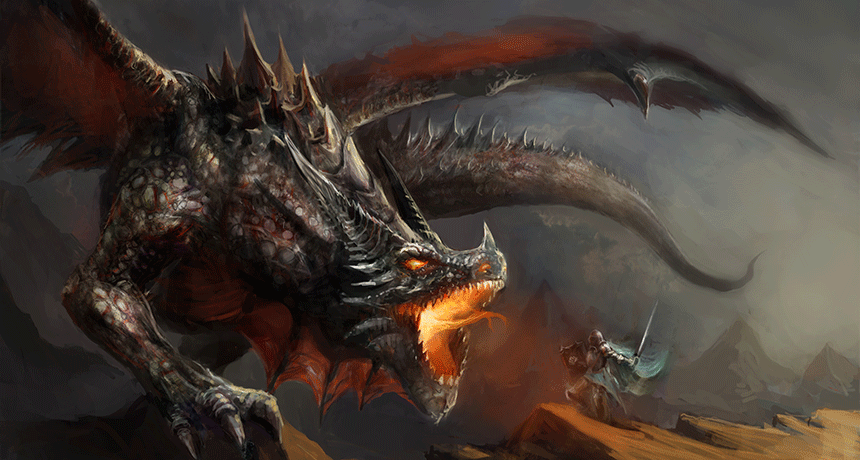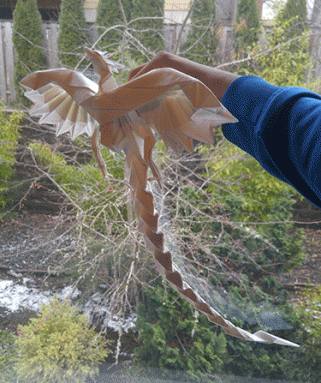How to build your dragon — with science
At the Regeneron Science Talent Search, science rules, even in fantasy

Dragons are creatures of fantasy, but you can still use science to design one.
fotokostic/iStockphoto
WASHINGTON, D.C. — How would you build a dragon? Maybe it would be red or black or green with shining scales. It could slither along the ground, or take to the air. It would breathe fire or ice or spit venom.
But that’s just what a dragon might look like. For a young scientist, that’s not good enough. How big is the dragon? How large do the wings need to be to make the animal fly? How do its legs work? How does it breathe fire? What are the scales made of? Maybe it’s not even alive, but a mechanical dragon buzzing through the sky.
Last year, as part of the judging process for the Regeneron Science Talent Search, finalists were tasked with designing a dragon, bringing science to fantasy. This yearly competition brings 40 high school seniors from across the United States here, to Washington, D.C., for a week. (Society for Science & the Public founded the competition and Regeneron — a company that develops treatments for diseases such as cancer and allergies — now sponsors it. Society for Science & the Public also publishes Science News for Students and this blog.) While the finalists are here, they share their winning science fair projects with the public and compete for almost $2 million in prizes.
But the competition isn’t a typical science fair. Competitors are challenged to think like a scientist and apply scientific concepts in new ways. To get a peek into the minds of these talented young scientists, we asked some of this year’s 40 finalists to tackle the dragon question. These high school seniors showed that even something as wild as a dragon can be designed with scientific knowledge and understanding.
We have liftoff
“When I think of a dragon, I’m thinking of a large, reptilian creature with large wings and [that is] able to fly,” says Benjamin Firester. The 18-year-old at Hunter College High School in New York City, N.Y., would base his dragon on a pterosaur. That’s a type of flying reptile that lived at the time of the dinosaurs. His dragon, he says, “would be thin, with very large wings and hollow bones.”
Large wings would help the animal generate lift — an upward force to get the dragon in the air. Hollow bones would help as well. They’d make the dragon lighter and easier to get off the ground.

Hollow bones are a key feature in birds and help them to fly. Sarah Gao, 17, decided to “bioengineer a very large bird.” The senior at Montgomery Blair High School in Silver Spring, Md., says she would combine the DNA — molecules that give cells instructions — from an ancient flying reptile such as a pterosaur with a modern bird. That, she reasoned, might produce a large flying reptile.
But not all the dragons the finalists designed were living and breathing. “I’ve done some work with drones,” notes Muhammad Rahman, 17. He’s a senior at Westview High School in Portland, Ore. Muhammad is an engineer and decided to make a mechanical dragon. He would use remote-controlled aircraft to make his beast take to the air. “You could make a dragon [sculpture] flap its wings and move like a bird,” he says, but it would take a lot of effort. Instead, he’d use drones to do the lifting, and the dragon’s wings would be just for appearances. “Engineering is about being efficient,” he says. “It’s about trying to make do with what you have.”
Fire away
Figuring out how to make that dragon breathe fire is a little less straightforward. For his mechanical dragon, Muhammad said he would have natural gas, which is used in some stoves, provide the flame.
A living model for breathing fire is a bit difficult to find, since none are known to exist. However, that did not deter Alice Zhang, 17. The senior from Montgomery Blair High School got her inspiration from bombardier beetles. These bugs mix two chemicals when threatened. The chemicals have an explosive reaction that the beetle shoots out its rear end. “I would take that and put it into a lizard somehow,” she says. (The resulting mix would have to come out of the dragon’s mouth, though, and not the other end.)
If you wanted real flame, Benjamin says, methane might be a good choice. This is a chemical that animals such as cows produce as they digest their food. Dragons could produce methane, he reasons, and a spark could set the chemical ablaze.
But no one wants a dragon to get toasted by its own flames. “I would implant something” that would produce fire in an engineered bird, says Sarah. The flames would go through a fire-resistant tube inside her dragon, helping the creature escape unscathed.
Fitting in
If dragons were real, they’d have to fit in somewhere in the environment. What would it eat? And where would it live?
Nitya Parthasarathy, 17, is a senior at Northwood High School in Irvine, Calif. She based her dragon on large lizards called komodo dragons. Komodo dragons make their living ambushing prey and scavenging animals that have already died. But they can’t fly. To get in the air, Nitya’s dragon would be a lot smaller, she says, “about the size of a bald eagle.” Her dragon’s diet would be smaller, too. “Like birds and reptiles, it could eat insects.”
Natalia Orlovsky, 18, also doesn’t see why a dragon has to be large. “I would build a small dragon. I’m thinking about the size of my palm,” says the senior at Garnet Valley High School in Glen Mills, Penn. A small dragon, she explains, wouldn’t suffer from biomagnification — a process by which the concentration of a chemical increases as it moves up the food chain.
Natalia worried that a top predator like a dragon might end up with a lot of pollutants from its food. Those pollutants might harm her dragon’s health. But a tiny one wouldn’t suffer that way. And it wouldn’t need to be a predator, either. “I’m thinking it would be a pollinator,” Natalia says. She would like it to help pollinate crops. Her dragon would live on nectar, and look much like a hummingbird.
And such a tiny fire-breathing creature would have a side benefit. “If they befriend people,” Natalia notes, “they’d be useful in toasting s’mores.”
Follow Eureka! Lab on Twitter